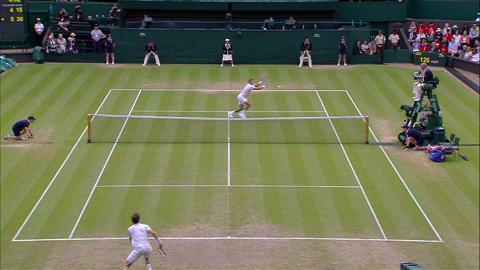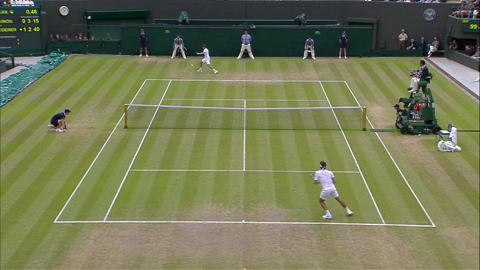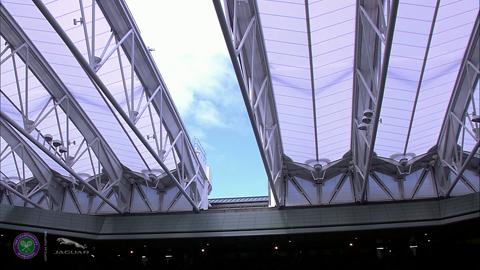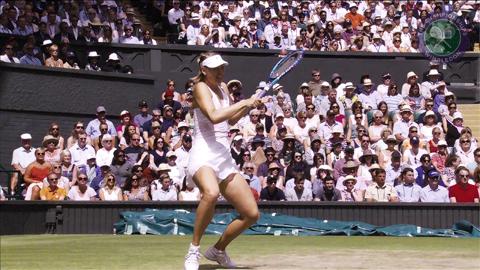For the better part of an intermittently rainy Wednesday, it looked as if the men’s quarter-finals were going to be no match for the women’s the previous day. As the top three players in the world cruised to resistance-free, straight-set wins, the most intriguing topic seemed to be who was in the BBC commentary booth. Then, as the sun set, tennis took over again. Here’s a look at five highlights from an afternoon that came in like a lamb, and went out like a lion.
The Other Andy Returns
That would be Andy Roddick, of course, who made his long-awaited debut in the tennis commentary booth for the BBC on Wednesday. Roddick, who has been mostly talking about other sports for a US network for the past year, lived up to the expectations most of us had for him.
He was funny. Asked if he had met David Beckham, Roddick said, “I haven’t yet, but I’ve long been an admirer of his hair."
He was wise. When asked about tennis’s most divisive topic, Nick Kyrgios, Roddick said, “So long as the personality is coming from a place of passion, I’m all for it. The not trying thing? I can’t get with that at all.”
And as he called the match between Novak Djokovic and Marin Cilic, it was clear that Roddick could bring insights to today’s game that older commentators can’t. First, there’s the fact that he knows the players personally, and has drawn up game plans against them (and, in Djokovic’s case, almost come to blows with him in a US Open locker room).
Just as important is the fact that Roddick, unlike former players from earlier eras, won’t complain about the current style of play. Specifically, he won’t bemoan the obvious fact that no one serves and volleys anymore. Roddick appreciates the game as it’s played now, and should be able to make the rest of us appreciate its underrated subtleties.
Question of Timing
Serving late in the first set against Andy Murray on Centre Court, Vasek Pospisil was given a warning for slow play by chair umpire Pascal Maria. Pospisil argued briefly, then went back to playing and was broken a minute later. The crowd in Centre Court roared for Murray; Twitter exploded in defense of Pospisil.
At that stage, Pospisil and Murray had each been taking, on average, a little more than the 20 seconds allowed between service points at Grand Slams. But neither was taking more than the 25 seconds that are, confusingly, allowed at all other ATP and WTA tournaments.
There were two issues here. First, the time allowed should be uniform at every event, including the Grand Slams – this would let the players maintain their pre-serve routines all year, and cut out any confusion. And there is confusion: Last year at Wimbledon, even Roger Federer was unaware that it’s 20, not 25, seconds at majors.
The second issue was whether Maria had jumped in when he shouldn’t have jumped in. The best way for a chair umpire to handle a plodding pro is to give him or her a “soft”, friendly warning on a changeover early in a set. Without a clock on the court, there’s no other way for the players to know that they need to pick up the pace. If that doesn’t work, the umpire should issue another, real warning as quickly as possible. The worst way to handle it is how Maria handled it: By coming out of the blue, and into the flow of play, when someone is serving at a crucial stage in a set.
Who Won It Best?
It was a cruise-control kind of day for the world’s three best players, Novak Djokovic, Roger Federer, and Andy Murray, none of whom dropped a set or were forced into a tie-break. Not that anyone expected them to struggle: Only Djokovic was facing a fellow top 10 player in Marin Cilic, and he had beaten Cilic 12 straight times.
Of the three, who was in the most ominous form? Federer played mostly free and easy tennis in his 6-3, 7-5, 6-2 win over Gilles Simon, a man who has taken him to five sets at Grand Slams twice in the past. Even when Federer had his 116-game unbroken streak snapped, he bounced back to break Simon right away. Federer played with a casual imperiousness, and rarely let the Frenchman take control of a rally. He also hit 11 aces and made 73 per cent of his first serves. Those sound like tournament-winning service numbers, but will he swing quite as easily on that shot against his next opponent?
That next opponent, of course, is Murray. The 2013 champion was much more solid than spectacular in his 6-4, 7-5, 6-4 win over Pospisil. Murray was content to rally and defend and force the Wimbledon quarter-final rookie to do something special with the ball. As Murray calculated, Pospisil, while he showed that he belongs with the big boys, couldn’t do something special enough, often enough.
1:00pm
Perhaps the most impressive and, for his fans, heartening performance came from Djokovic. Not only did he beat the highest-ranked opponent, Cilic, by the numbingly routine scores of 6-4, 6-4, 6-4, Djokovic did it without the benefit of a rest day on Tuesday. With 27 winners, 12 errors, and 72 per cent of first serves made, Djokovic’s game appeared to fall neatly back into place after his five-set scare against Kevin Anderson in the previous round.
Best of all for Djokovic, though, may have been what happened in the day’s fourth quarter-final...
Richard the...Lion Hearted?
The first thing we can say about that last quarter-final, between Richard Gasquet and Stan Wawrinka, is that a lot happened.
It lasted three hours, 28 minutes, and produced 119 winners over the course of its 323 points. The play, as expected, was a mix of the brilliant and bewildering. Gasquet and Wawrinka, each famous for his one-handed backhand, pushed and pulled each other all over No.1 Court, and passed each other mercilessly at the net. But each also handed over a set with a double-fault.
Their last meeting, at Roland Garros in 2013, had ended in a Wawrinka victory, 8-6 in the fifth set; and in the two years since, Stan seemed to have distanced himself further from Gasquet. Which meant that when Gasquet couldn’t serve out the match today at 5-3 in the fifth, it appeared certain that Wawrinka, who has been touted as the newest member of the Big Four, would end up the winner.
Instead it was Gasquet, determined not to lose after blowing a lead, who held firm through the long overtime fifth set, and it was Wawrinka whose big-swinging ways finally caught up with him. You never know when a player will revert to form. You never know when a player will surprise you by leaving his past behind. And you never know when a routine day will turn into anything but.












































